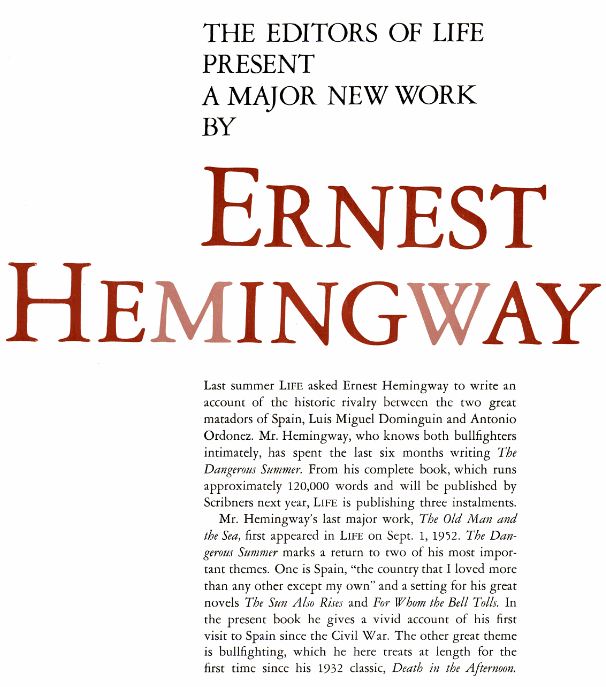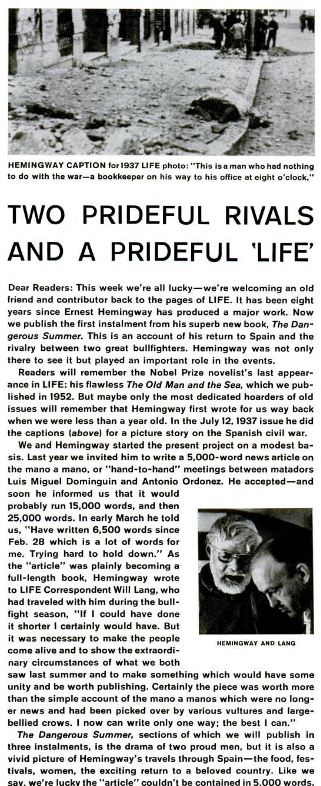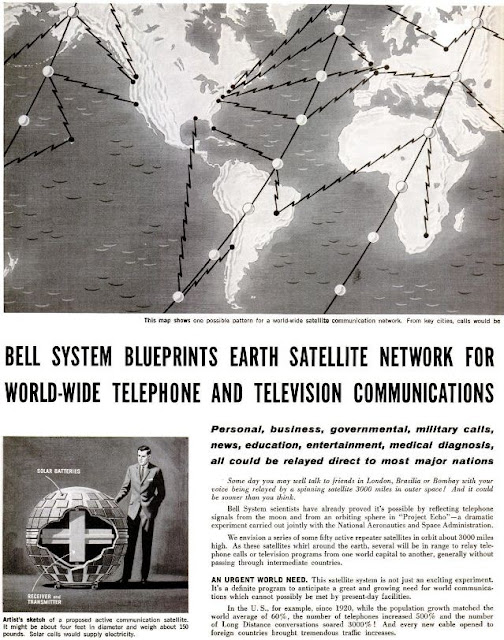For we Australians, the Dangerous Summer quite possibly still lies ahead. Things have been bad enough as it is. And Covid-19 isolation is all the more excruciating when one is cooped up without a decent magazine to read. We subscribe to The New Yorker and Britain’s Literary Review. Subscriptions work out a lot less expensive than waiting to buy copies at the newsagent’s, and by rights magazines such as these should arrive by mail two to three weeks ahead of them reaching the stands. But rights went out the window when Australia Post laid off staff and, with the pandemic, parcels started to pile up. One estimate has 2½ million items still waiting to be delivered.
Our mags are now starting to slowly trickle in. But earlier this month, in
desperation, I went back to my extensive magazine stockpile, and dragged out a
copy of LIFE from precisely 60 years
ago. It was the issue of September 5, 1960, with a smiling Ernest Hemingway on
the cover and the first instalment of Hemingway’s bullfighting epic The Dangerous Summer inside.
LIFE said “we’re all lucky – we’re welcoming an old friend and contributor
back … It has been eight years since Hemingway produced a major work [The Old Man and the Sea, which won him
the Nobel Prize for literature in 1954. This had appeared in LIFE on September 1, 1952, and two
million copies of the magazine sold in two days].” LIFE
commissioned The Dangerous Summer in
the middle of 1959 (on September 7, 1959, it published a 10-page picture spread
from Larry Burrows and James Burke of mano
a mano fights Hemingway covered.) Hemingway left Cuba for Spain via New
York on July 25, 1959, and returned to New York at the end of October. LIFE originally asked for 5000 words
and promised payment of $30,000 ($53.60 a word in today’s money). But Hemingway
produced 108,746 words on 688 typed pages. His friends A.E. Hotchner and LIFE’s Paris bureau chief William J.
Lang helped Hemingway trim down the piece and by March they had
pruned it to 63,562 words. LIFE published
35,000 words in three instalments. Even then, one Virginian reader described The Dangerous Summer as “elephantine
pirouetting”, “self-conscious cuteness” and a “blizzard of tortured verbiage”.
Other
than the 24 pages LIFE devoted to Hemingway, the September 5, 1960, issue
covered many other interesting topics: letters about votes for women, a
full-page tribute to the great songwriter Oscar Hammerstein II, who had died in
August 23, a colour ad for a Smith-Corona Galaxie portable typewriter, Sirimavo
Bandaranaike becoming the prime minister of Ceylon (now Sri Lanka), and thus
the world’s first female prime minister (she eventually served three terms over
40 years), Princess Ira von Fürstenberg and her marriage at age 15 to Prince
Alfonso of Hohenlohe-Langenburg (he was
31) and her relationship with Francisco “Baby” Pignatari, a Brazilian industrialist
eight years older than Alfonso, and a couple of creepy young TV extras. I was also intrigued by the double page ad
for a Bell System earth satellite network.
My
favourite item, however, was this one about the guy who jumped the fence before
the Opening Ceremony at the 1960 Olympic Games in Rome and ran 200 metres to
the finish line. I’d done much the same thing before the opening of the 1988
Seoul Olympic Games, except in my case the stands were still empty and I didn’t
manage a 200m sprint, just a gentle jog to the line.






















































